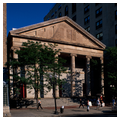St. Paul's was the first major Greek Revival–style building erected in Boston. In constructing this church, the Episcopal congregation explicitly rejected the Gothic style. For the body of the church, Alexander Parris used Quincy granite, but the Ionic portico and
You are here
St. Paul's Cathedral
1819–1820, Alexander Parris; 1913–1927, Ralph Adams Cram. 138 Tremont St.
If SAH Archipedia has been useful to you, please consider supporting it.
SAH Archipedia tells the story of the United States through its buildings, landscapes, and cities. This freely available resource empowers the public with authoritative knowledge that deepens their understanding and appreciation of the built environment. But the Society of Architectural Historians, which created SAH Archipedia with University of Virginia Press, needs your support to maintain the high-caliber research, writing, photography, cartography, editing, design, and programming that make SAH Archipedia a trusted online resource available to all who value the history of place, heritage tourism, and learning.




















